|
This post originally appeared at bonvito.wordpress.com in November 11, 2010. Wilfredo Ronquillo is currently the head of the Archaeology Division of the National Museum of the Philippines and one of the pioneers of Philippine archaeology. The original article was published in 2001, and a lot more discoveries/projects have been added to current understanding of Philippine archaeology. This narrative, however, provides us with a general perspective about work done regarding Philippine prehistory and heritage. SOURCE: Ronquillo, Wilfredo. 2001. Philippines in Encyclopedia of Archaeology: History and Discoveries. (ed.) Murray, Tim. Tim Murray: Santa Barbara, California. 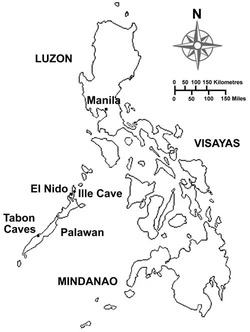 The Philippines, lying at the eastern margin of mainland Asia, has been a crossroad for the movements of peoples and ideas from the mainland to the Pacific islands since prehistoric times. Manila likewise has been the key entrepôt of maritime trade and commerce, notably during the almost 250 years (from 1564 to 1815) when the Manila galleons sailed the Pacific Ocean between Manila and Mexico. Philippine archaeological resources, both on land and under water, are abundant and phenomenal. Archaeological sites range from the earliest indirect evidence for the presence of man in Cagayan Valley, northern Luzon, during the Middle Pleistocene to sixteenth-century dugout wooden coffin burials in northeastern Mindanao. Recent archaeological finds in the country also indicate the existence of complex societies in the northern, central, and southern Philippines, the latter dating as early as the ninth century A.D. Important archaeological discoveries also include a flotilla of plank-built and edge-pegged wooden boats found in a waterlogged environment that range in date from the fourth to the thirteenth centuries a.d. Throughout Southeast Asia and, indeed, the world at this time, only in the Philippines are such prehistoric boats known to exist. The history of archaeology in the Philippines elucidates the rich and varied archaeological wealth of the country, as well as the pivotal roles that pioneering individuals played in the evolution, history, and growth of archaeology in the country. For convenience, this updated history is presented in periods that parallel the political administrations of the archipelago from the sixteenth century to the present: the Spanish Period (1521-1898); the American Period (1898-1946); the post-World War II era and the 1950s; the l960s; the 1970s; the 1980s; and the 1990s to the present. Space limitations allow the inclusion of only the most important archaeological discoveries since the 1960s. The Spanish Period (1521-1898) Although Ferdinand Magellan reached the Philippines on March 16, 1521, Spanish colonization of the archipelago did not begin in earnest until 1565. The Spanish explorers and colonizers noted the variety of Philippine cultures and languages. The early Spanish chroniclers of Philippine society and culture were generally members of religious orders; they primarily wrote ethnographic reports intended for Spain’s ruling monarch or their own religious superiors. The early Spanish writings were mostly descriptive in character, depicting, in varying details, the physical appearances and lifeways of the Filipinos as observed by the writers. At a later time a great deal of linguistic studies were conducted and subsequently published together with the ethnographic reports. Several chroniclers reported on archaeological discoveries, including Antonio de Morga, the vice-governor general of the Philippines in the seventeenth century who, in his Sucesos de las Islas Filipinas, noted ancient artifacts found by farmers in Luzon. The only recorded important archaeological reconnaisance undertaken in the archipelago during the Spanish period was conducted in 1881 by Alfred Marche, a French archaeologist who systematically explored the central Philippines and discovered numerous sites. He collected varied archaeological specimens, mainly porcelains and stonewares recovered primarily from burial caves. The majority of his collections are now kept at the Musée de l’Homme in Paris. Marche’s exploration activities at Marinduque Island became “the most successful Philippine archaeological expedition recorded from Spanish times” (Beyer 1947, 260). An Austrian, professor Ferdinand Blumentritt, also published a series of articles about the Philippines and its people around this time. Cursory exploration of caves and open archaeological sites were undertaken in several areas in the Philippines between 1860 and 1881, including those by the German traveler Feodor Jagor in 1860 and J. Montano and Paul Rey between 1879 and 1881. The American Period (1898-1946) The Philippines were occupied by the United States in 1898, and the U.S. administration of the archipelago began a year later. President William McKinley created the Taft Commission in 1900 in an attempt to craft proper legislation for the Philippines. The commission, in turn, established the Bureau of Non-Christian Tribes. This bureau, which changed names through the years, was placed under different institutions and was eventually abolished. In 1901 the first government museum was created, designated as the Insular Museum of Ethnology, Natural History, and Commerce, and was placed under the Bureau of Non-Christian Tribes. In the course of its existence the museum went through various changes, but it was never abolished. Today, it isa government bureau within the Department of Education, Culture, and Sports and is now officially called the National Museum. 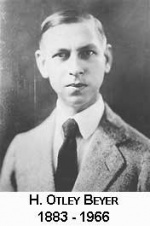 Considered the founder of Philippine archaeology, Henry Otley Beyer (1883-1966), an American from Iowa, arrived in Manila in 1905 to join the civil service. His pioneering works resulted in much of what was known about Philippine prehistory. Three years with the Philippine Bureau of Education found him among the Ifugao of northern Luzon, serving as a schoolteacher and documenting their lifeways. In 1914 he founded the Department of Anthropology at the University of the Philippines, and his first writing on Philippine archaeology came out in 1921. As head of the anthropology department, Beyer studied the racial and cultural history of the country. From 1922 to 1925 Carl Guthe from the University of Michigan led an archaeological expedition to the central Philippines. Guthe was the first trained archaeologist to work in the archipelago, and his exploration activities focused on the collection of ceramics in the hope that these materials would shed light on the early maritime trade between the Philippines and mainland Southeast Asia. He identified 542 archaeological sites and collected more than 30 cubic tons of archaeological specimens, which are now are kept at the University Museum of the University of Michigan. Early 1926 saw Beyer’s first involvement in field archaeology, via the accidental discovery of major prehistoric sites at Novaliches during the construction of a dam for the water supply of Manila. Beyer’s ensuing investigation was to be the start of the Rizal-Bulacan Archaeological Survey. By the middle of 1930 excavation activities had also reached Bulacan Province, and in five years of work a total of 120 sites had been identified, with the collection of almost half a million specimens. Personnel of the National Museum conducted surveys and excavations during the 1930s. In 1934 Ricardo E. Galang, the first Filipino-trained archaeologist, spent two months excavating fourteenth- to fifteenth-century sites at Calatagan, Batangas. In 1938 he investigated a jar burial at San Narciso, Quezon. He recorded a total of six jar burial and midden sites in the area and recovered associated materials of shell bracelets, beads, and ceramics. In 1938 Generoso Maceda, another staff member of the National Museum, identified a jar burial site in Pilar, Sorsogon Province, in southern Luzon. Twenty-four jars containing artifacts were excavated in three sites (Evangelista 1962, 21). In 1940 Olov Janse, a Swedish-American archaeologist with support from Harvard University, conducted archaeological excavations in the Calatagan sites. Working in three sites, he excavated a total of sixty-six graves, the results of which were published in the annual report of the Smithsonian Institution (Janse 1946). There was a complete cessation of archaeological activities during the Japanese occupation of the archipelago (1941-1945). Beyer, who was under conditional internment, was assisted by Tadao Kano, a Japanese civilian assigned to protect museums in the Philippines. The Japanese allowed Beyer to continue working at the museum of the University of the Philippines and at the Institute of Ethnology and Archaeology, which enabled him to pursue his research writing and complete the final sections of his major postwar publications (Evangelista 1962; Jocano 1975; Solheim 1981). 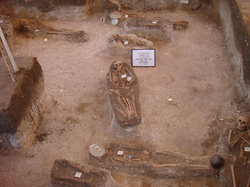 Post-World War II and the 1950s An increased interest in the beginnings of Philippine society and culture developed in the years after World War II, and archaeology as a course was included in the curriculum at the University of the Philippines. Beyer’s research writings during the war years resulted in two important publications, his “Outline Review of Philippine Archaeology by Islands and Provinces” and hisPhilippine and East Asian Archaeology, and Its Relation to the Origin of the Pacific Islands Population (Beyer 1947, 1948). These major works are invaluable as references for archaeologists working in the Philippines to this date. Archaeological exploration and excavation activities resumed in the l950s, led by two Americans, Wilhelm G. Solheim II and Robert B. Fox. Both were pivotal in arousing the interest of a number of Filipinos to pursue careers in archaeology. With an M.A. in anthropology from the University of California, Solheim published his first work on Philippine prehistory and archaeology in 1951. He conducted archaeological excavations from 1951 to 1953 in Masbate Island with two Filipino students, Alfredo E. Evangelista and E. Arsenio Manuel. Archaeological data generated from the excavations there were collated with the archaeological materials from the Guthe collection recovered in the 1920s from the central Philippines, resulting in The Archaeology of the Central Philippines: A Study Chiefly of the Iron Age and Its Relationships (Solheim 1964). Fox (1918-1985) wrote avidly and extensively about Philippine ethnology, archaeology, and natural history from the late 1940s until 1973. He stayed in the Philippines after his service with the U.S. Navy during the war. With B.A. and M.A. degrees in anthropology, Fox was active in Philippine ethnography before focusing his attention on the archipelago’s prehistory. Major fieldwork in the 1950s was undertaken through the National Museum under the direction of Fox, working with Evangelista and several other members of the museum staff. In 1956 Fox and Evangelista excavated the Sorsogon Province of southern Luzon. A jar burial/stone-tool assemblage was encountered; the sites range in date from 2900 to 2000 b.p. The most extensive archaeological project in the middle of the 1950s was the Calatagan, Batangas, Archaeological Project south of Manila led by Fox. Over 500 pre-Spanish graves were excavated in a number of burial sites, resulting in the recovery of thousands of trade ceramics-Chinese and Siamese porcelains and stonewares of the late-fourteenth to early-sixteenth centuries a.d. Extended primary burials were revealed as well as secondary burials in jars, with some graves exhibiting evidence of teeth filing and ornamentations. It is unfortunate that the 1950s excavations at Calatagan would witness the start of widespread pothunting activities, which continue to this day. The 1960s Fox led major archaeological activities for the National Museum from 1962 to 1966 in a number of caves along the west coast of Palawan, known collectively as the Tabon Caves. Work in this area resulted in the discovery of late-Pleistocene human fossil remains and associated stone implements. Going back to over 30,000 years ago, six successive periods of prehistoric occupation were found. The C-14 dates available for the Tabon Caves range from 30,500±1100 b.p. and 9250±250 b.p. At nearby Manunggul Cave an earthenware burial jar was found with incised and hematite-painted designs about the shoulder and cover (the latter having a ship-of-the-dead motif dating from 890 to 710 b.c.); it is now one of the country’s National Cultural Treasures. The preliminary results of the archaeological work at the Tabon Caves were published by Fox in 1970. This work included information on human bone fragments that, although recovered from a disturbed area of the caves, have been dated from 22,000 to 24,000 years ago-still the earliest evidence for Homo sapiens in the Philippines. In 1966 significant archaeological sites were discovered right in the city of Manila. Known as the Santa Ana Sites, they exhibited both habitations and burials that “date more than 400 years before the arrival of the Spaniards in Manila” (Fox and Legaspi 1977, 1). The main burial site excavated was originally an archaeological mound on which the present Santa Ana Church was built, and the associated tradeware ceramics recovered from the burials date from the late eleventh to the fourteenth centuries a.d. 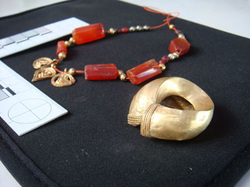 In 1967 cursory underwater archaeological activities were undertaken by the National Museum and the Times-Mirror-Taliba, a now-defunct newspaper outfit, in Albay, 500 kilometers south of Manila. Believed to be a Spanish galleon, the ship was found 40 to 65 meters below the surface. In addition to two large designs. C-14 dating of shells recovered from this site resulted in dates ranging from 8000 to 6500 b.p. Shell adzes were also noted from Duyong Cave, Palawan, in the Ryukus Islands, and on other Pacific islands. The 1970s The 1970s saw a profusion of archaeological research undertaken by both Filipino and foreign archaeologists. The elephant fossil sites in Cagayan Valley, northern Luzon, which had previously been reported, were explored and excavated in the 1970s by the National Museum. Led by Fox, the research uncovered hundreds of fossilized remains of mammals such as elephants, stegodon, rhinoceros, crocodile, giant tortoise, pig, and deer, as well as flaked and cobblestone tools (Fox and Peralta 1972). The first three large mammals in this group are now extinct in the Philippines. Encumbered by geological problems in the open sites of Cagayan Valley, Richard Shutler Jr., then with the University of Iowa, was crucial in sending to the country a succession of geologists and geomorphologists from Iowa State University. Led by Carl Vondra in 1977, these researchers defined the Plio-Pleistocene terrestrial sequence in the Cagayan Valley basin, demonstrating the in situ association of artifacts and Pleistocene fauna, the age of artifacts, and the Plio-Pleistocene environments in the valley. Geological research has since solved the majority of the problems of the Pleistocene geology of the area, but the debate over the age of the artifacts still continues. In 1972 Solheim and A. M. Legaspi led an archaeological survey of coastal southeastern Mindanao, a joint project of the National Museum and the University of Hawaii (Solheim, Legaspi, and Neri 1979). The Talikod rock-shelter sites, where flaked shell and stone tools were recovered, are the earliest sites recorded from the survey, with dates ranging from 7620 ±120 b.p. and 3950±90 b.p. Two ethno-archaeology studies were undertaken in the 1970s. The first was conducted by Bion and Agnes Griffin among the Agta Negritos in the Sierra Madre range of northeastern Luzon from 1974 to 1976. With the goal of providing models for adjustments to hunting and gathering in wet and seasonal environments, the researchers hoped that the results of the study might be utilized for an archaeological understanding of hunters in tropical settings. 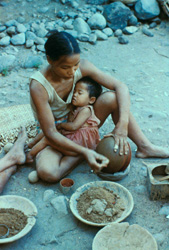 William Longacre of the University of Arizona directed an ethno-archaeological study in pottery-making villages in Kalinga Apayao, northern Luzon. Designed to provide data directly relevant to archaeological methods for inferring patterns of behavior and organization of peoples who lived in the past, the project, now in its third decade, has revealed significant insights into the manufacture, distribution, uses, breakages, and discarding of ceramics and how these and other material culture relate to human behavior. From 1977 to 1978 archaeological surveys and limited excavations were undertaken in Iloilo Province, Panay, in the central Philippines. Australian archaeologists from the Victoria Archaeological Survey, led by Peter Coutts, focused their research on the establishment of a regional sequence, on the study of tradeware ceramics on Panay Island, on the recording of local pottery-making traditions and their trading networks, and on the collection of osteological materials for comparative studies. While the geologists were working out the problems at the open sites at Cagayan Valley, the National Museum archaeologists concentrated their research activities in Penablanca, about 15 kilometers east of the Pleistocene open sites. Led by Wilfredo Ronquillo and R. A. Santiago, exploration activities in the limestone area resulted in the recording of over 100 caves and rock shelters, eight of which have since been excavated. Basically aimed at elucidating the structure and distribution of the stone-tool industries in the area, the technological and functional analyses of the lithic flaked tools and debitage recovered from the excavations of Rabel Cave (ranging from 4900 to 3000 b.p.) indicated the generalized functions of the flake tools, which made them ideal for use as maintenance tools; the manufacture of the stone flaked tools involved a percussion method without core preparation. In 1977 Barbara Thiel, then a graduate student at the University of Illinois, excavated two caves at Penablanca, Cagayan Province-Arku by the recovery of cordage of palm fibers. Their presence indicates that an older ship-building method was used. The Butuan archaeological assemblage points to a complex society in this area, indicated by craft specialization (such as wood, bone, and shell working, pottery manufacture, bead reworking, and metallurgy-specifically gold working) and the capability to participate in long-distance trade. In 1979 an archaeological program led by Karl Hutterer of the University of Michigan started an interdisciplinary project focused on the prehistoric social and cultural development of a small geographical area in Negros Oriental. Known as the Bais Anthropological Project, the research, participated in by graduate students from Michigan, generated archaeological, ethnographic, biological, and geological data used to provide an overall understanding of prehistoric and present-day societies in Negros. The 1980s Archaeologists from the National Museum were busy during the 1980s. Although limited in manpower, the museum is the only institution that undertakes full-time archaeological research activities in the country. One of its priority activities is rescue archaeology, which involves the investigation of caves prior to the mining of bat droppings for use as fertilizer. In 1981 archaeological exploration activities started at the limestone formation of Anda, in the island province of Bohol in the central Philippines. Designed to explicate the island adaptation of prehistoric man, this project, led by Santiago, resulted in the discovery of over 130 caves and rock shelters, the majority of which are archaeological sites. A number of caves exhibit wooden coffin burials as well as rich prehistoric habitation and burial sites. Museum archaeologists were active in various areas in the country, such as Laurel, Batangas; Ma-ug, Prosperidad, Agusan del Norte; and Polillo Island, Quezon Province. Important archaeological data were generated from the continuation of the excavations at the Butuan sites in northeastern Mindanao, where primary extended burials indicate teeth filing and blackening. Laura Junker, Hutterer’s former student and now a professor of anthropology at Vanderbilt University, did research in Tanjay, Negros Oriental, in the central Philippines. Concentrating on the operation of control over the distribution of prestige goods, tradewares, and earthenware ceramics, Junker used archaeological and ethnohistoric data to test the hypothesis that early Philippine chiefdoms’ participation in Southeast Asian luxury goods trade during the tenth to the sixteenth centuries a.d. was strongly linked to centralized control of a complex intraregional system of production, exchange, and resource mobilization. In the 1980s numerous underwater archaeological sites were worked by the National Museum. The various shipwrecks found in Philippine territorial waters include Spanish, English, American, and Asian craft, usually with portions of the cargo still intact. The tradeware ceramics help date the ships and cargo. The associated archaeological materials have added new insights into the history of the trade from the ninth to the eighteenth centuries, as well as the nature of the trade and the societies that produced, bartered, and used the goods. In the majority of cases the sites explored and excavated were worked as joint ventures with private entities. The shipwrecks studied include: one believed to be a merchant boat, found in 1982 on the southeast coast of Marinduque Island, about 150 kilometers south of Manila; a probable local watercraft found in 1983 at Puerto Galera, Mindoro Island; and a sixteenth-century wreck found in 1985 at the Royal Captain Shoal, a coral reef west of Palawan Island. The archaeological materials recovered from this site include porcelain plates, saucers, bowls, cups; boxes and box covers; blue-and-white, pear-shaped, terra-cotta bottles; jarlets; jars; over 200 beads; 33 identical gongs; and bronze, iron, and copper objects. The tradewares recovered from the wreck point to the Wan Li period (1573-1620). It was also in 1985 when the Griffin, an East India Company vessel, was excavated northwest of Basilan Island in the southern Philippines. Along with numerous Chinese tradeware ceramics, the few metal objects found include iron ingots used as ballast, iron tools in the form of adzes, cannonballs, lead sheets used to line the wooden tea crates, lead musketballs, teapots, a Chinese coin of copper alloy, shoes and belt buckles of copper alloy and gilt bronze, and other objects used for daily life on board the ship. In 1986 the exploration for the sunken galleon San José was started off the waters of Lubang Island, Mindoro Province. Only portions of the ship’s planks, numerous shards of blue-and-white chocolate cups, and fragments of bronze, iron, and copper materials were recovered. The 1990s to the Present Important archaeological discoveries were made in the 1990s. In 1991 earthenware potteries with covers exhibiting anthropomorphic motifs were excavated at Ayub Cave, Pinol, Maitum, Sarangani Province. Led by E. Z. Dizon, the analysis of the potteries, designed and formed like human figures with varied and distinct facial expressions, indicates that they were used as covers for multiple secondary burial jars. Typologically the jars and the associated materials found date to the Metal Age period in the Philippines, around 500 b.c. to 500 a.d.  The year 1991 also marked the start of an archaeological survey for the Spanish warship San Diego, which sank off Fortune Island on December 14, 1600. A joint project of the National Museum and World Wide First, Inc., the excavation found the wreck at a depth of about 50 meters below the sea’s surface. Two seasons of underwater archaeological excavation were undertaken, resulting in the recovery of over 34,000 archaeological items, including tradeware porcelains and stonewares, earthenware vessels, metal artifacts, and various organic materials. The archaeological materials recovered from the San Diego site include more than 500 blue-and-white Chinese ceramics in the form of plates, dishes, bottles, kendis (spouted water containers), and boxes that may be ascribed to the Ming dynasty, specifically to the Wan Li period; more than 750 Chinese, Thai, Burmese, and Spanish or Mexican stoneware jars; over seventy Philippine-made earthenware potteries influenced by European stylistic forms and types; parts of Japanese samurai swords; 14 bronze cannons of different types and sizes; parts of European muskets; stone and lead cannonballs; metal navigational instruments and implements; silver coins; 2 iron anchors; animal bones and the teeth of pigs and chickens; and seed and shell remains of prunes, chestnuts, and coconut. Noteworthy among the metal finds are a navigational compass and a maritime astrolabe. Also retrieved from the site is a block of hardened resin that was noted in historical accounts to have been used for caulking and for making fire in stoves. A summary of the excavations and finds is presented in C. Valdes’s Saga of the San Diego, published in 1993. In the northernmost islands of the Philippines, the Ijangs (megalithic structures situated in elevated hills, indicating evidence of fortification) were confirmed through archaeological explorations and limited excavations. Led by Dizon and Santiago, the cursory archaeological activities indicate that the structures closely resemble the castles reported from Okinawa and date to the twelfth century a.d. These recent finds may prove crucial in the understanding of the formation of sociopolitical complexities in the Philippines. This concise history of archaeology in the Philippines records the fascinating story of the search for the prehistoric beginnings of the archipelago, which is inextricably linked with mainland Southeast Asia and the Pacific islands. Although it may seem that archaeological activities in the country are adequate, there are still countless archaeological sites in the country that need proper assessment, excavation, and management. Unfortunately, these important and nonrenewable components of the country’s cultural resources are also subject to plunder, nearsighted exploitation, and vandalism. Properly managed and protected, these archaeological resources have educational, recreational, and tourism potential. Without doubt, they are worth protecting for the enrichment and enjoyment of succeeding generations.
187 Comments
The 2011 UOG Cebu Archaeological Field School application deadline is fast approaching. We want to finalize plans by the end of March.
We will be using this blog site to post updates and announcements. Events, activities, and news from the field will be available here. |
AuthorS.B.Acabado Archives
June 2011
Categories
|
 RSS Feed
RSS Feed
